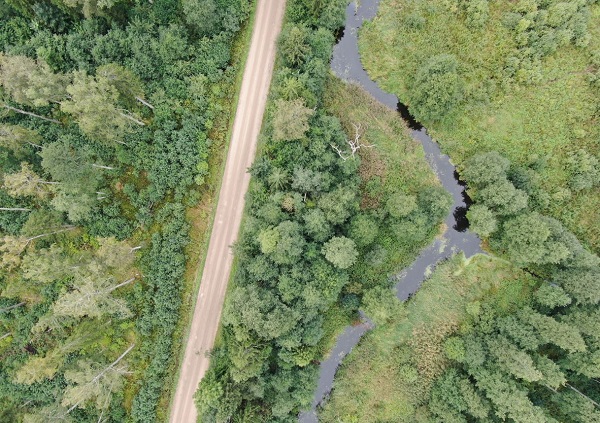Water Quality of the Aģe River to be Improved as Part of a Project
In order to reduce pollution in the Aģe River, JSC “Latvia’s State Forests” (LVM) and Latvian State Forest Research Institute “Silava” experts will install green and blue infrastructure elements on the banks of the Aģe and Tora rivers within the framework of the European Union integrated LIFE programme project “LIFE GoodWater IP”, as well as will set up a demonstration site to organize events to inform the public about water quality improvement solutions and opportunities.
The area of the Aģe River basin reaches almost 215 square kilometres. Data from the Latvian Environment, Geology and Meteorology Centre show that the river water status does not correspond to high quality due to pollution and other conditions. One of the problems to be solved in the Tora River is to ensure smooth flow of the river. Therefore, within the framework of the project it is planned to remove dry and unstable spruces in the immediate vicinity of the watercourse and in the river itself, while preserving the deciduous tree sediments and their parts that create shading, as well as preserving some of the sediments in the river bed itself, as long as it does not impede the flow of water.
Environmentally friendly elements to be built in the forest drainage system
In order to reduce the flow rate of the river, it is planned to build environmentally friendly elements in the existing forest drainage systems connected to these rivers: a dam combined with a special pond, in which overflow pipes will be placed, as well as a sedimentation pond corresponding to the area of this river basin, which will facilitate the settling of unwanted particles and organisms entering its bed, thus purifying the water. There will also be a pedestrian footbridge on the dam, which will allow visitors to take a closer look at the new structures.
River protection zones to be diversified
It is also planned to diversify the river protection zone in the course of the project, performing works in a two-kilometre-long strip up to 50 metres wide on both sides of the Tora. The planned works include diversifying the composition of tree species in order to reduce the number of spruces and promote the growth of deciduous trees in the immediate vicinity of the river and thus facilitate the release of litterfall, which is valuable for aquatic organisms. In the specific forest massif, the activity of beavers provides the necessary and complementary function of “natural engineers” without dominating the environment or suppressing other processes. Currently, beaver gnawing signs are already to be seen in the northern part of the site, which promotes the formation of openings in tree stands, thus naturally promoting the diversity of deciduous and herbaceous plants.
Specialists will assess the impact of railway on water quality
As the demonstration site is located very close to the planned Rail Baltic route, the project also considers how to measure the long-term impact of railways on rivers, thus obtaining unique data on the impact of relatively large deforested areas on watercourses and their mitigation progress.
At the same time, in the territories of both rivers, it is planned to set up educational routes for visitors, creating park-like structures for the promotion of tree species diversity and ground cover vegetation, combining them with stand diversification. There will also be a wooden shield trail to facilitate the movement of visitors in the wettest places, as well as to produce and install information signs and stands.
Planning work will be started in 2021 to sequentially implement activities and create a demonstration site during the next five years.




